Vitamins lec 1 د ناهده خلف Vitamins are naturally occurring organic
advertisement
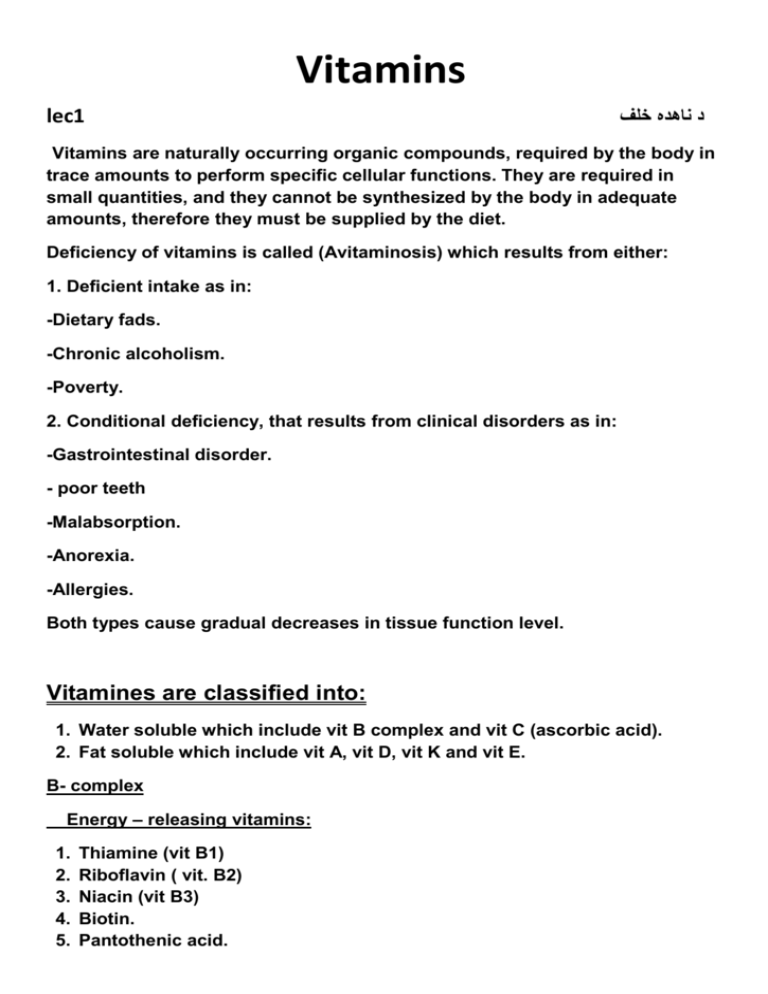
Vitamins lec1 د ناهده خلف Vitamins are naturally occurring organic compounds, required by the body in trace amounts to perform specific cellular functions. They are required in small quantities, and they cannot be synthesized by the body in adequate amounts, therefore they must be supplied by the diet. Deficiency of vitamins is called (Avitaminosis) which results from either: 1. Deficient intake as in: -Dietary fads. -Chronic alcoholism. -Poverty. 2. Conditional deficiency, that results from clinical disorders as in: -Gastrointestinal disorder. - poor teeth -Malabsorption. -Anorexia. -Allergies. Both types cause gradual decreases in tissue function level. Vitamines are classified into: 1. Water soluble which include vit B complex and vit C (ascorbic acid). 2. Fat soluble which include vit A, vit D, vit K and vit E. B- complex Energy – releasing vitamins: 1. 2. 3. 4. 5. Thiamine (vit B1( Riboflavin ( vit. B2) Niacin (vit B3) Biotin. Pantothenic acid. Haematopoitic vitamins: 1.Folic acid. 2.Vit. B12 Other vitamins 1.Pyridoxine (vit B6) 2.Pyridoxal. 3.Pyridoxamine. Many of the water-soluble vitamins are precursors of coenzymes. Water –soluble vitamins are not toxic and stored in small quantities, they are readily excreted in the urine. They must be continually supplied in the diet ,also the absorption of some Require the presence of intrinsic factor, which is a glycoprotein secreted by the stomach,so gastrectomy patients may show deficiency symptoms. Animal food is the only source of vit B12. METABOLISM: Most water –soluble vitamines are absorbed in the hepatic-portal vein, stored ,bound to enzymes and protein and excreted in the urine. Thiamine (vitamine B1) The active form of vit B1 is diphosphate, which is converted by ATP – dependant enzyme present in the brain and liver called diphosphotransferase. Thiamine pyrophosphotase is a coenzyme serves in enzymatic reactions: in which an activated aldehyde unit is transferred. 1.Transketolase reaction; that is necessary for the formation of glyceraldehydes 3-p Ribose 5-p Glyceraldehyde 3-p 2.It is also involved in citric acid cycle. Distribution of thiamine Found in almost all plant and animal food, unrefined cereal grain and meat are good source of vitamin B. Deficiency of thiamine: Periphral neuropathy and anorexia, odema, cardiovascular and muscular degeneration. Beri-Beri disease is a severe deficiency of thiamine; 1.Infantile beri- beri include: Tachycardia,vomiting,convulsions and may leads to death if it is not treated. 2.Adult beri-beri is characterized by dry skin,irritability,disorderly thinking and progressive paralysis. RIBOFLAVIN ( Vitamine B2 ) The active forms of riboflavin are: 1.Flavin mononucleotide (FMN) 2.Flavin adenine dinucleotide (FAD). FMN is formed by ATP-dependant phosphorylation of riboflavin; while FAD is synthesized by a further reaction with ATP in which the AMP moiety of ATP is transferred to FMN. Its function as coenzymes; Flavoproteins undergo reversible reduction of iso alloxazine ring to yield the reduced forms: FMNH2 and FADH2. Distribution of Riboflavin: Found in milk, egg, liver, yeast and kidney are good sources of riboflavin.It is synthesized by plants and microorganisms but not by mammals. Deficiency of Riboflavin: Include: 1. Dermatitis. 2. Cheilosis. (Fissuring at the corners of the mouth). 3. Glossitis( the tongue appears smooth and purplish). Niacin (Nicotinic acid and Nicotinamide) : Are both coenzymes for many oxido-reductase.they act with enzymes dehydrogenase; involved in carbohydrate,lipids and aminoacids metabolismas in the citric acid cycle. The mechanism of oxidoreduction involves: areversible addition of hydride ions [H] to the pyridine ring plus the generation of a free hydrogen ions (H). H + NAD + A H2 NADH +H + +A Distibution : It is found in most animal and plant food, unrefined grains and cereal, milk and meats. Clinical indication for Niacin; A .Deficiency of Niacin leads weight loss, dermatitis,digestive disorders. ,diarrhea.and depression(central nervous system). B. Treatment of hyperlipidemia Nicotinic acid is used for lowering serum cholesterol, due to inhibition of free fatty acid from adipose tissue. Biotin Is widely distributed in natural food, it is a coenzyme in carboxylation reactions in which it serves as a carrier of activated carbon dioxide pyruvate carboxylase e.g : Pyruvate oxaloacetate Biotin Distribution of Biotin: Biotin is present in almost all food; liver,milk and egg yolk.. Deficiency of Biotin Biotin deficiency does not occur naturally because the vitamin is widely distributed in food; also a large percentage of biotin requirements are supplied by intestinal bacteria. PANTOTHENIC ACID The active form of it is the [ coenzyme A] . CoA occurs in citric acid cycle. Fatty acid synthesis,oxidation and acylation reaction and cholesterol synthesis. Its functions in the transfer of acyl groups. e.g: CoA-SH+ fatty acid Fatty acyl CoA. LEC .2 Pyridoxine( vitamine B6) Vitamin B6 consist of 3 closely related naturally occurring pyridine derivatives. 1.Pyridoxine 2.Pyridoxal. 3.Pyridoxamine. All these three derivatives are equal in activity as precursors for the coenzyme ; the phosphate derivatives ,this coenzyme helps many enzyme of amino acid metabolism by entering into the Schiff base combination between its aldehyde group and the amino group of an α- amino acid. The reactions are transamination, Deamination,Decarboxylation and condensation. Transamination: It is a transfer of an amino group of an α- ketoglutaric acid as in the enzyme GOT and GPT Oxaloacetate +Glutamate Aspartate +α – ketoglutarate Deamination: Serine Pyruvate +NH3 Decarboxylation: Histidine Histamine + CO2 Condensation: Glycine +Succinyl CoA α – aminolaevulinic acid Schiff base Pyridoxal phosphate also has a function in glucogenolysis( breakdown of glycogen). Distribution of vitamin B6: Vit B6 is found in liver, egg, meat,vegetable and banana. FOLIC ACID Folacin has the biochememical activity of folic acid. Yeast, liver , leafy vegetables are the major sources for folic acid. Active folate: is the tetrahydrofolate which is formed by a reduction occurs in the intestinal cells by the enzyme folate reductase,in this reaction NADPH is used as a donor for [H]. Tetrahydrofolate is the functional coenzyme in tissue, it is the carrier of activated one carbon unit, which carry on in oxidation- reduction reaction. e.g Serine glycine. and so further for synthesis of purine and pyrimidine. Clinical indication: Folic acid deficiency result in growth failure and megaloblastic anemia (decrease DNA synthesis): this state may be caused by: 1. Increased demand with adequate loss of folate such as in pregnancy and lactation. 2. Poor absorption due to pathological disorder of the small intestine. 3. Alcoholism. Vitamin B12 (cobalamine) It is synthesized by microorganisms , liver is also a good source for vitamin B12 ,the commercial preparation is cyanocobalamin. Intrinsic factor is necessary for absorption of vit B12. The active coenzyme forms of Vit B12 are : 1.methylcobalamine. 2.Deoxyadenosylcobalamine which help in the conversion of methylmalanoyl-CoA to succinyl CoA (in the citric acid cycle). It also help in the gluconeogensis. Absorption of Cobalamine: Mammals absorbed cobalamine using aspecialized transport system.,here the stomach secret a glycoprotein called INTRINSIC FACTOR (IF),which binds cobalamine to the intestinal lumen. The cobalamine-IF complex is taken by a specific receptor in the lining of the ileum . The vitamin is released from the IF inside the ileal epithelial cells and then transported across the opposite side of the plasma membrane into the blood stream, cobalamine then bound to transcobalamine II,which enable it to enter the liver. The most reliable therapy is I.M injection of cobalamine, a normal person require less than 10 µg of cobalamine / day. Nutritional deficiency of cobalamine is rare except in strict vegetarian;as this vitamin is found in all animal sources. Methylcobalamine is coenzyme in the combined conversion of : 1. Homocysteine to methanionine and 2. Methyltetrahydrofolate to tetrahydrofolate In this reaction a methyl group is removed from the coenzyme to homocysteine to form methionine, The next step is the removal of the methyltetrahydrofolate to tetrahydrofolate. Deficiency of vitamin B12 Leads to megaloblastic anemia. Pernicious anemia result from lack of intrinsic factor especially in patients who had gastrectomy. Role of vitamines in the citric acid cycle Four of the water soluble vitamins of B-complex group have roles in the function of the citric acid cycle. 1. Riboflavin in the form of flavin adenine dinucloetide (FAD). 2.Niacin in the form of nicotinamide adenine dinucleotide, the coenzyme for 3-dehydrogenase in the cycle isocitrate citrate dehydrogenase and αketoglutaric dehydrogenase and malate dehydrogenase. 3. Thiamine (B1) as thiamine diphosphate, the coenzyme for decarboxylation in the- ketoglutarate dehydrogenase reaction. 4. pantothenic acid; as part of coenzyme-A the Coenzyme attached to active acyl residue, such as acetyl-CoA ans succinyl CoA (its function in transfer of acyl group). Ascorbic acid (vitamin C): Vit C act as coenzyme 1. Acts as a donor of reducing equivalents and it is oxidized Dehydroascorbic acid,which is asource of vitamin C. NADP NADPH Ascorbic acid dehydroascorbic acid. 2. Also it has a good role as coenzyme in hydroxylation as Vit C Proline hydroxyproline Proline hydroxylase Proline hydroxylase Lysine lysine hydroxylase 3.vitamin C acts as antioxidants. Distribution: Citrus fruits, potates, Tomato, and green vegetables. Clinical Indication of Vit C: Deficiency of Vit C results in scurvy, a diseases characterized by 1. Sore, spongy gums. 2. Loose teeth. 3. Fragile blood vessels. 4. Swollen joints. 5. Anemia. 6. Weakness. 7. Subcutaneaus hemorrhage. 2. Prevention of chronic diseases: Vitamin C act as antioxidants (i.e inactivate the free radicals). LEC 3 COENZYMES Coenzymes are organic substances of known chemical composition. In most cases being derivetives of vitamins. Most of the water soluble vitamines are Coenzymes,after some change in the structures. Their functions are by helping in the carriage or transport of one of the products of the enzyme reactions. The Coenzymes differ in their action from that of the cofactors.The Cofactors are mostly trace elements that play a role in the activity of the enzyme. (e.g : Copper,zinc,iron and manganese……..) Function of Coenzymes: Substrate + Enzyme+ Coenzyme Activated complex Enzyme+ O product + Coenzyme-product complex Product + Coenzyme Example: The role of pyridoxal phosphate in transamination reactions: Aminoacid + Pyridoxal phosphate Ketoacid + pyridoxamine phosphate Thiamine Coenzyme (Thiamine pyrophosphate) ….TPP TPP participates in three kinds of enzymatic reaction: 1..Non oxidative decarboxylation As the decarboxylation of α- ketoglutarate to form succinate. 2.Oxidative decarboxylation as the decarboxylation of pyruvic acid to form Acetaldehyde. 3.Transketolation ( transketolase enzyme) As xylulose 5- phosphate Fructose 6- phosphate. Niacin Coenzyme ( nicotinamide adenindinucleotide) NAD ……….Coenzyme I Or adenine dinucleotide monophosphate…..NADP…..Coenzyme II The Coenzyme act as acceptor of hydrogen atoms. NAD NADH (H+) The enzyme systems requires NAD are: 1.L – malate dehydrogenase.. 2. Mitochondrial isocitrate dehydrogenase. 3. Lactate Dehydrogenase. (LDH). 4. Glyceraldehyde 3- phosphate dehydrogenase. NADP act on: 1. Cytoplasmic isocitrate dehydrogenase. 2. Dihydrofolate reductase. RIBOFLAVIN: FMN……..flavin mononucleotide. FAD………flavin adenine dinucleotide. Their function are in oxidation – reduction reaction. Substrate+ FMN or FAD Oxidized substrate +FMNH2 or FADH2 BIOTIN Its Coenzyme is N- carboxybiotinyl lysine, its function as a CO2 transfer in the reaction of the enzyme B – carboxylase Example : 1. Malonyl CoA transcarboxylase. 2. Pyruvate CoA transcarboxylase. 3.propionyl CoA trancarboxylase. Folic Acid: The Coenzyme of it is tetrahydrofolic acid (THF) , this Coenzyme is required for the transfer of a single carbon unit. Cynacobalamine: B12 Coenzyme ; (cobamide) this enzyme is required in the transfer of carboxyl group. Pantothenic acid (Coenzyme A): This Coenzyme is widely involved in the transfer of acyl groups (HsCoA),it is involved with thiokinase enzyme. Vitamin C: This Coenzyme is ascorbate which is involved as antioxidant in all oxidation - reduction reactions. Role of Metals in oxidation and reduction reaction 1.succinate dehydrogenase and NADH dehydrogenase both are iron – sulfer enzymes and non –haem iron protein. 2.Cytochromes – haem iron proteins. 3. Oxidase and hydroxylase – copper containing enzyme. As dopamine hydroxylase ,in the biosynthesis of norepinephrine .copper is involved as a cofactor in the activity of the enzyme dopamine hydroxylase.
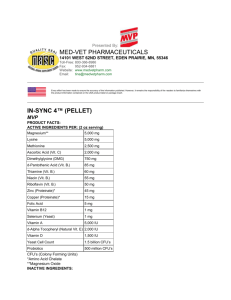
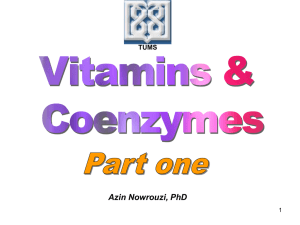
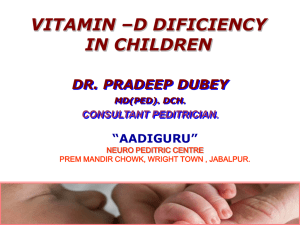
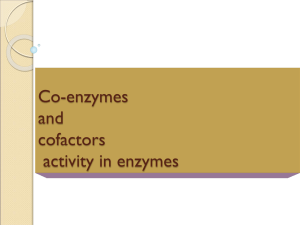
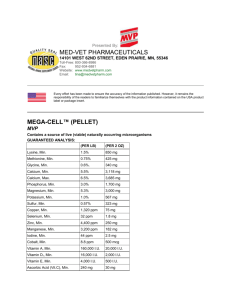
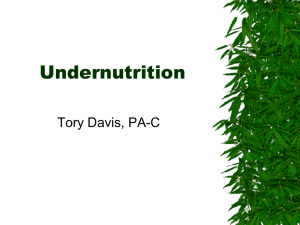
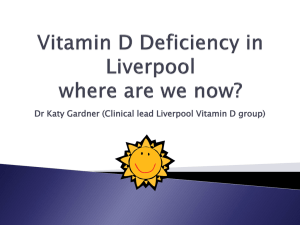



![njc27_publication_14[^]](http://s3.studylib.net/store/data/007269384_1-e6dfd9e9ce907c419bcf0d1cc06fae96-300x300.png)